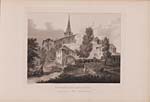(33) Plate XIV/a
Download files
Individual page:
Thumbnail gallery: Grid view | List view

Plate XIV.
LOCH-AN-EILAN.
BESIDES several of the
most extensive lochs in Scotland, if we except Loch Lomond, the
bold and moun-
tainous county of Inverness, can claim the possession of many
smaller ones, the beauties and picturesque
scenery of which are equal to most of the kind. Of the latter there
are several on the estate of Grant of
Rothiemurchus; two of them a short distance from the house. One of
these called Loch Gaun, is wholly
surrounded by fir wood, which clothes nearly to their summits the
bold mountains, that almost encom-
pass it. Another, Loch-an-eilan, is the subject of the present
plate. It takes its name from a small
island, upon which there are, still tolerably entire, the walls of
an old castle. These insulated castles
were formerly strongly fortified, and were frequently resorted to
by their owners the barons, in times of
danger. The present castle, of the period of whose erection there
is no tradition, is said to have been the
object of a most obstinate and cruel contest between the Shaws and
the Cummings in the fourteenth
century; and at a later period, during the rebellions in 1715 and
1745, it was defended by the ancestors
of its present possessor. On the summit of a mountain, to the west
of this view, is a large stone, known
by the name of "Argyle's Stone," which tradition reports to have
been the first resting-place of one of
that family, when defeated by another clan in a battle fought
thirty miles from the spot, about a century
ago. The scenery about this loch is particularly wild and romantic,
and from the situation of the sur-
rounding hills, there is formed a remarkable echo, which repeats a
single sound seven times very distinctly.
"The skirts of a large mountain" (see Remarks on local Scenery in
Scotland) "are usually productive of
grand scenery. It is the case here. Among the declivities, that
form the base of the mountains are several
secluded spots singularly wild and romantic, in one of which is
placed Loch-an-eilan." The district, or
parish, which composes the estate of Rothiemurchus, is said to
derive its name from the Gaelic "Raat-
mhor-ghuish," "the great plain of fir," and is bounded by the
river Spey on the north, and a range of
the Grampians, of which the famous mountain of Cairn-gourum is one
of the most lofty, on the south.
This mountain is 4060 feet high, and is remarkable from having
given its name to a species of coloured
Quartz Chrystals, which are found of great beauty and considerable
size on these hills.—This view was
taken in 1799.
Set display mode to:
![]() Universal Viewer |
Universal Viewer | ![]() Mirador |
Large image | Transcription
Mirador |
Large image | Transcription
Images and transcriptions on this page, including medium image downloads, may be used under the Creative Commons Attribution 4.0 International Licence unless otherwise stated. ![]()
| Scotia depicta > (33) Plate XIV/a |
|---|

